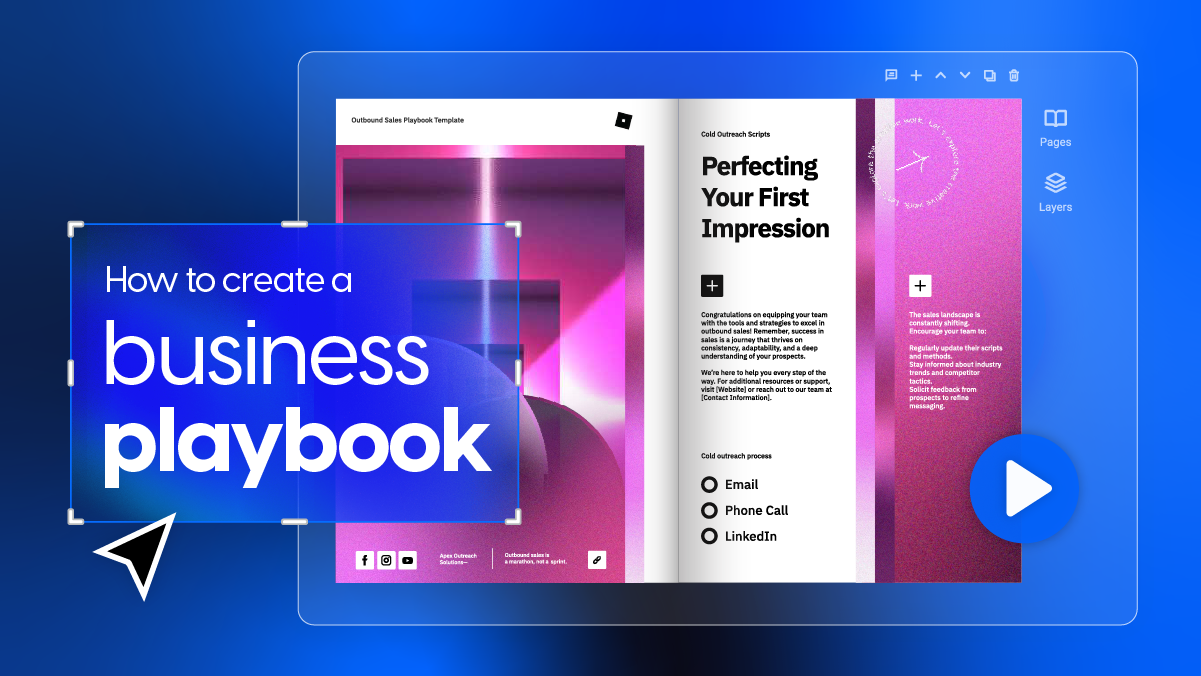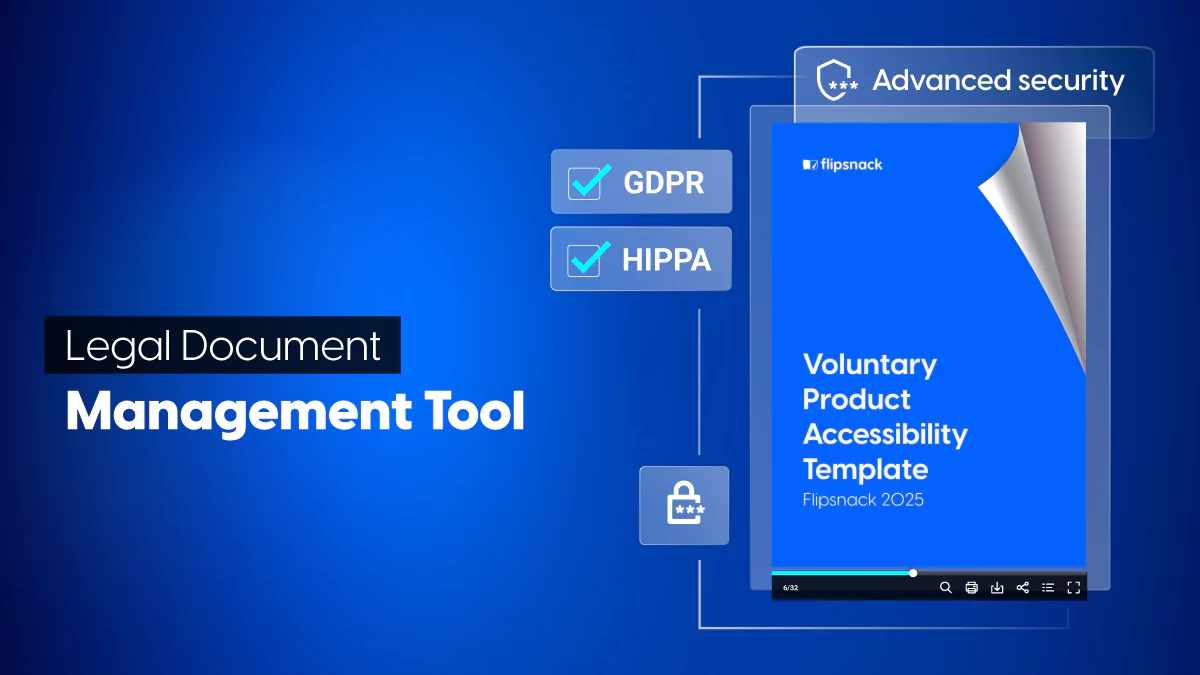How to Create a Business Playbook. The Ultimate Step-by-Step Guide
Running a business without a plan is like driving without a map—you might reach your destination, but not efficiently. Create a business playbook to streamline operations, improve consistency, and ensure a smoother journey to success.
But what exactly goes into it? And what tools can help you create one?
Let’s take a closer look at how to create an interactive playbook that aligns with your company’s goals and sets you up for long-term success.
Understanding the business playbook and why you should have one
A business playbook is a comprehensive guide that outlines your company’s overall strategy, workflows, and best practices. It provides a big-picture view of how your business operates and includes areas like:
- Company values and mission
- Sales and marketing strategies
- Customer service protocols
- Crisis management plans

Benefits of having a business playbook
Having a company playbook keeps your team aligned and working efficiently. Without one, employees rely on scattered information or trial and error. (Which leads to mistakes and wasted time.)
With a structured playbook, onboarding becomes easier, daily operations run smoother, and scaling feels less chaotic. It sets clear expectations so your team knows exactly what to do and who’s responsible — no confusion, no mixed messages. And when leadership shifts or challenges arise, a playbook can help keep everything running smoothly.
This is especially important for remote teams, multi-location businesses, or fast-growing companies.
How to successfully create a business playbook
Before creating your playbook, review your business’s mission, values, and long-term goals.
What’s your core reason for operating? What are your core principles and why? Where do you hope to see your business in 10 years? 20 years?
Then, run through the following steps.
Step 1: Define your objectives
How will your playbook help support your business? Define specific, measurable goals that align with your business strategy.
Consider your target audience. Will managers, new hires, or experienced employees use it? Tailor content to their needs to promote more engagement and clarity. For example, a customer service team may require detailed troubleshooting steps, while a leadership team might need decision-making frameworks.
If your company operates in multiple departments, you may need separate playbooks for different functions. (Think HR, IT, marketing, and customer service.)
Step 2: Gather the necessary information
Collect documentation on existing business processes, policies, and key performance indicators (KPIs). Interview department leaders and employees to capture insights and best practices.
Make sure to also gather details about your company culture, mission, and values. (Including notes about leadership styles and workplace values helps employees see how they fit into the bigger picture.)
If you’re working with multiple documents, you might need to combine them into a single file before uploading them to your playbook. Instead of managing separate PDFs, merge PDFs first to keep everything organized. This way, you won’t have to deal with missing pages or fragmented content when turning your file into a digital playbook.
You might also look at your competitors’ playbooks to see how they do things. Check out their customer service, HR, and marketing playbooks to spot areas where you can improve.
Step 3: Structure the playbook
Choose a format for your playbook. For instance, you might create a digital flipbook, PDF guide, or downloadable ebook.
Whichever type you choose, make sure it includes:
- An executive summary: An overview of the playbook’s purpose.
- Company values and culture: Core principles that guide decision-making.
- Key processes and procedures: Step-by-step instructions for essential operations.
- Roles and responsibilities: Clear expectations for each position.
- Performance metrics and evaluation: Benchmarks for success.
- Crisis management protocols: Contingency plans for disruptions.
Use visuals such as charts, flow diagrams, and checklists to improve understanding. The easier it is to navigate, the more likely employees will reference and follow it. You can also include videos and other interactive details.
Here’s a breakdown of each section you should include in your playbook.
Executive summary
Start with a high-level explanation of why the playbook exists, who it serves, and what employees can expect from it.
Company values and culture
Define the core principles that guide decision-making within your company. Include your mission statement, core values, and workplace expectations.
Employees should also understand how company culture influences their roles and responsibilities. Highlight how these values translate into daily operations. For example, if customer-first service is a key principle, explain how it impacts policies and workflows.
Key processes and procedures
Detail essential workflows and procedures in a step-by-step format.
This section will be your employees’ go-to guide on how to complete tasks efficiently. (So give it extra attention.)
Be sure to include:
- Standard operating procedures (SOPs) for key tasks.
- Flowcharts to illustrate complex workflows.
- Checklists for repeatable processes.
Clarity is key. Employees should be able to reference these processes without needing additional explanations.
For instance, if you’re including a SOP about how to transition to new tools, explain the steps. And include a practical example, like this:
“If you need to look for Avalara alternatives, for instance, start by comparing related tools on G2 and Capterra. Search “Sales Tax Compliance Software” on both review sites to pull up similar tools. Then, read through the reviews and compare star ratings. Please also read more in-depth review guides from bloggers we trust, like Adam Enfroy. When you’re finished, suggest three tools we can switch to. (Amanda is currently in charge of operations, so sync up with her.)”
Roles and responsibilities
Define job roles and expectations for each position. Outline responsibilities, reporting structures, and how different teams collaborate.
For example, in a sales playbook, specify who handles lead generation, client communication, and contract finalization. In an IT playbook, define responsibilities for system maintenance, cybersecurity, and troubleshooting.
Performance metrics and evaluation
Set clear benchmarks for success. Establish KPIs that employees should aim for — whether it’s sales quotas, customer satisfaction scores, or operational efficiency metrics.
Be sure to also provide a framework for performance reviews and ongoing assessments.
Crisis management protocols
Outline emergency response strategies, communication protocols, and escalation procedures. Employees must know exactly what steps to take in case of cybersecurity threats, PR crises, or operational failures.
Step 4: Develop clear and concise content
Use simple, direct language when writing your playbook. Avoid jargon and lengthy explanations.
Instead, focus on short step-by-step guides and real-world examples to help reinforce concepts. (Remember the example we shared above.)
Consider adding decision trees or FAQs within each section to proactively answer common questions. Interactive elements, such as quizzes or video tutorials, can also help with understanding and retention.
Step 5: Incorporate tools and resources
Add links to the software that supports your business operations, along with resources to help employees use them.
For example, an employee onboarding playbook might include a login to your HR software and helpful tutorials. A content production playbook might provide links to your proofreader tool, SEO tool, and writing templates — along with short guides on how to use them. Using a sentence rewriter ensures text is clear, concise, and professional, helping maintain consistency across documents.
Proofreading the content of your playbook ensures that it is free from any typos and grammatical errors. These errors can impact the company’s professionalism and credibility. Many teams rely on virtual assistant companies to help maintain consistency and support day-to-day execution.
Step 6: Review and revise
Get feedback from your team and update the content as things change.
You could also try pilot programs where a few employees test parts of the playbook before everyone uses it.
Step 7: Implement and train
Introduce the playbook through training sessions and workshops. Encourage employees to use it as a daily reference.
Keep training employees to make sure they’re up-to-date with the latest processes. When new procedures come up, update the playbook right away to keep everything consistent.
Step 8: Monitor and measure success
Use performance metrics to see how well your playbook is working.
Host review meetings to talk about what’s working well and what can be improved. (And change things based on what the data shows.)
For example, if the customer service playbook leads to faster responses and fewer issues, it means the process is clear. If some parts get ignored, they might need to be simpler or clearer.
How to create a business playbook using Flipsnack?
1. Upload your PDF playbook or use a template
Flipsnack gives you two simple ways to create your playbook: upload an existing PDF or start with a template. If you’ve already designed a playbook in another tool but need a more effective way to present and share it, just upload your file and Flipsnack will transform it into a sleek, interactive format.
Using a template is the fastest way to achieve a professional look without designing every page manually. Flipsnack offers a variety of playbook templates, helping you structure content efficiently while maintaining a polished design. Simply select a template, customize it with your branding, and add the content that supports your strategy. Users also have the option to start from scratch if they want to.
Once your business playbook is ready, you can edit text, rearrange pages, and adjust visuals.
2. Add your company’s branding and interactive elements
Once you’ve uploaded your PDF or chosen a playbook template, it’s time to personalize your content. With Flipsnack, you can edit every page directly. Adjust text, swap images, and refine layouts. Need to add more details? Duplicate pages effortlessly, or remove sections that no longer fit your playbook’s objective.
Flipsnack’s intuitive drag-and-drop Design Studio makes visual customization simple. Upload images and integrate charts to highlight key insights. Want to make your playbook more dynamic? Embed videos, GIFs, and links to enhance engagement and ensure a richer reading experience.
For a polished, branded look, apply your logo, brand colors, and fonts using Flipsnack’s branding options, keeping everything consistent and professional. Before finalizing, review each page to ensure your message is clear, impactful, and aligned with your business goals.
3. Include your team in making business playbooks
With Flipsnack, collaboration is seamless. Invite team members to edit, review, or comment on your playbook in real-time. Instead of managing multiple file versions, your team can work on the same document together, ensuring a smooth and efficient editing process.
Assign full editing access to those making changes or comment-only access for feedback. Need input on specific pages? Use the built-in commenting feature to leave notes directly on the playbook, keeping discussions organized and actionable.
4. Share your business playbook
Once your playbook is finalized, Flipsnack provides multiple secure sharing options tailored to your needs. Instead of sending large email attachments, generate a shareable link that works on any device, allowing clients, investors, or stakeholders to view it instantly – no downloads required.
For added privacy and security, Flipsnack offers several controls:
- Unlisted sharing keeps your playbook hidden from search engines and your public profile—only those with the link can access it.
- Password protection ensures only authorized viewers can open the document by requiring a password before access.
- Private sharing allows you to send the playbook via email, restricting access to specific recipients. This method requires a Flipsnack account for viewing, making it the most secure way to share sensitive content.
Or use public sharing options by sending your playbook via email or social media, embedding it on your company’s website, or even sharing it via a QR code.
Choose the sharing options that best suits your business needs.
5. Track business playbook’s engagement
Wondering if your playbook has been opened by key stakeholders? With Flipsnack, you no longer have to guess. You can track exactly how your audience interacts with your playbook.
With Flipsnack’s statistics, users can monitor who viewed it, how long they spent on each page, and which sections drew the most engagement. These insights help you refine your content and focus on what resonates most.
If you share your playbook via a private link, you can track individual viewer activity and see engagement rates, so you’ll know if clients, investors, or team members are reading through or dropping off early. Use this data to optimize your playbook and ensure your key messages make an impact.
Create a business playbook that drives results
A business playbook gives your operations structure and encourages performance. It helps your team stay on track, work more efficiently, and scale effectively.
Start building or refining your playbook now. Document the key processes that matter most to your team and business — and package them up into a cohesive playbook.

(Remember, your playbook shouldn’t stay the same. Keep updating it as your business grows!)
PS: Want to create a playbook that makes your operations run smoothly? Use Flipsnack’s easy-to-use platform to design, customize, and share interactive playbooks. Try one of our editable templates now.
FAQs about business playbooks
Structure your business playbook into clear sections, including:
– An executive summary
– Company values and culture
– Key processes and procedures
– Roles and responsibilities
– Performance metrics and evaluation
– Crisis management protocols
Be sure to include essential processes, guides, performance metrics, and key business strategies in your playbook.
A business plan shows your company’s big goals and how you plan to reach them. A playbook, on the other hand, explains how to run things day-to-day. It gives clear steps for getting tasks done and keeping everything consistent. (Your playbook essentially helps you make sure your business plan happens.)
A comprehensive playbook covers the business functions that run the whole organization. SOPs focus on individual tasks.




